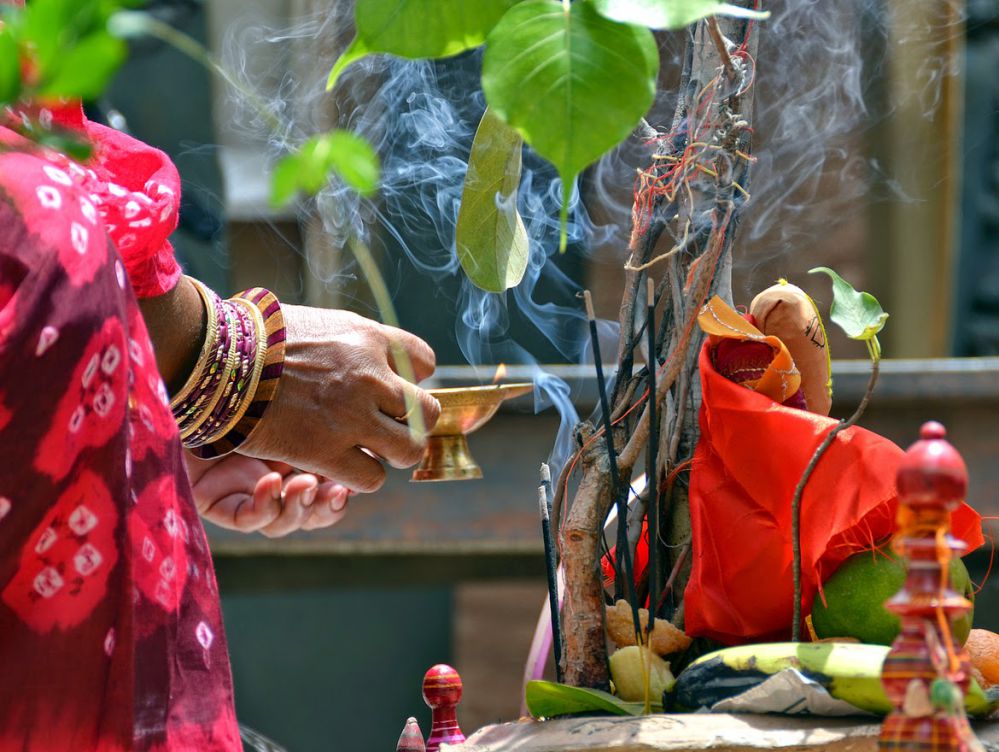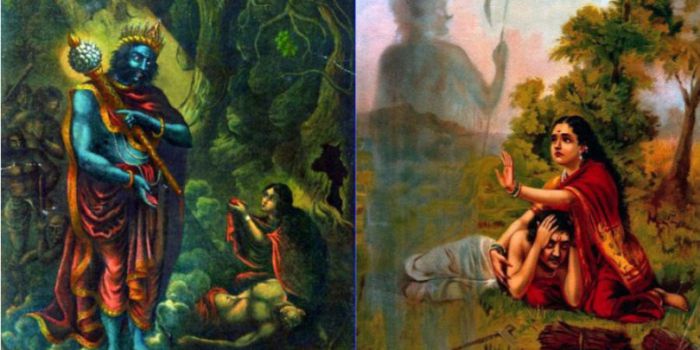No products in the cart.
Vat Savitri Vrat in North India and Sabitri Brata in Orissa is a fasting observed by married women for the well-being of their husbands and for a happy married life on Amavasya, the new moon day in the Bikram Sambat month of Jyestha. It is also known as Sabitri Uwaans in Western Odisha region or Savitri Amavasya. On this day, women performing the puja observe fast(eating only fruits and soaked raw Moong Dal during the day, after performing puja) and worship Banyan Tree (Vat). The fast is dedicated to Savitri and Satyavan; her husband who was destined to die within one year but was brought back to life by her penance. Soon Satyavan also regained his lost kingdom.
During the puja they read out or listen to Sabitri Brata Katha which is a poetic rendition of how Maha Sati Savitri saved her husband from the clutches of Yamaraj by dint of her virtues and devotion.
The story of Satyavan and Savitri is a sub plot in the Mahabharata.
Savitri Vrat Katha
King Ashtapati had a beautiful and intelligent daughter named Savitri. The King gave her the permission to choose her husband. One day, Savitri met a young man in the forest who was carrying his blind parents in two baskets balanced on either side of a stick. The young man was Satyavan.
Impressed by Satyavan’s devotion towards his blind parents, Savitri decided to marry him. Upon enquiry, the King found out from Sage Narada that Satyavan was the son of a deposed king and that he was destined to die in a year.
King first refused to give permission for the marriage but Savitri was adamant. Finally, the King relented and the marriage was conducted and the couple left for the forest.
They led a happy life and soon a year passed. Savitri realized that the date Sage Narad had predicted for Satyavan’s demise would fall in three days time.
Therefore, three days before the predicted day of death of Satyavan, Savitri started fasting.
The day Satyavan was destined to die, Savitri followed him to the forest. While cutting woods from a Vat Vriksha (Banyan Tree), he fell down and fainted.
Soon, Savitri realized that Satyavan was dying. Suddenly she felt the presence of Yama, the god of death. She saw him carrying the soul of Satyavan and she followed Yama. Yama first ignored Savitri thinking that she will soon return back to her husband’s body. But she persisted and kept following him. Yama tried few tricks to persuade her but nothing worked. Savitri remained adamant and said that she would follow her husband where ever he goes.
Then Yama said that it was impossible for him to give back the dead as it is against the nature’s law. Instead, he will give her three boons and she should not ask to return her husband’s life as a boon.
Savitri agreed to this.
With the first boon she asked that her in-laws be reinstated in their kingdom with full glory.
With the second boon she asked for a son for her father.
Finally, for the third boon she asked ‘I would like to have children.’
Yama immediately said ‘granted.’
Then Savitri said, ‘now that you have granted me the boon of having children please return my husband as I can only have children from him.’
Soon Yama realized that he had been tricked by Savitri, a pativrata.
Yama remained silent for a minute and then smiled and said ‘I appreciate you persistence. But what I liked more was you readiness to marry a man whom you loved even though you knew that he would only live for a year. Go back to your husband he will soon wake up.’
Soon Savitri returned to the Vat Vriksha were her husband was lying dead. She started going round ( Pradakishna) the Vat Vriksha and when she completed the Pradakshina, Satyavan woke up as if from sleep.
Savitri and Satyavan were, therefore, reunited.
People worship Vat Vriksha and perform Savitri puja in memory of this event.
Savitri Vrat Puja Vidhi
- All Hindu women observe this festival by worshiping and propitiating Savitri as a Devi. Early in the morning, women take purifying baths, wear new clothes and bangles, and apply vermilion on their foreheads.
- Nine types of fruits and nine types of flowers are then offered to the Goddess. Wet pulses, rice, mangoes, jackfruits, palm fruits, kendu, bananas and several other fruits are offered as Bhoga (offering) and the festival is observed with Savitri vrat katha.
- After fasting for the whole day, the women take the Bhoga and wash feet of their respective husbands with water and have the same water in order to break their fasting.
- It is believed that the ritual is incomplete if the fasting women don’t take their husbands’ feet washed water. In the afternoon, when formalities of worship are over, they bow to their respective husbands and elderly people.







